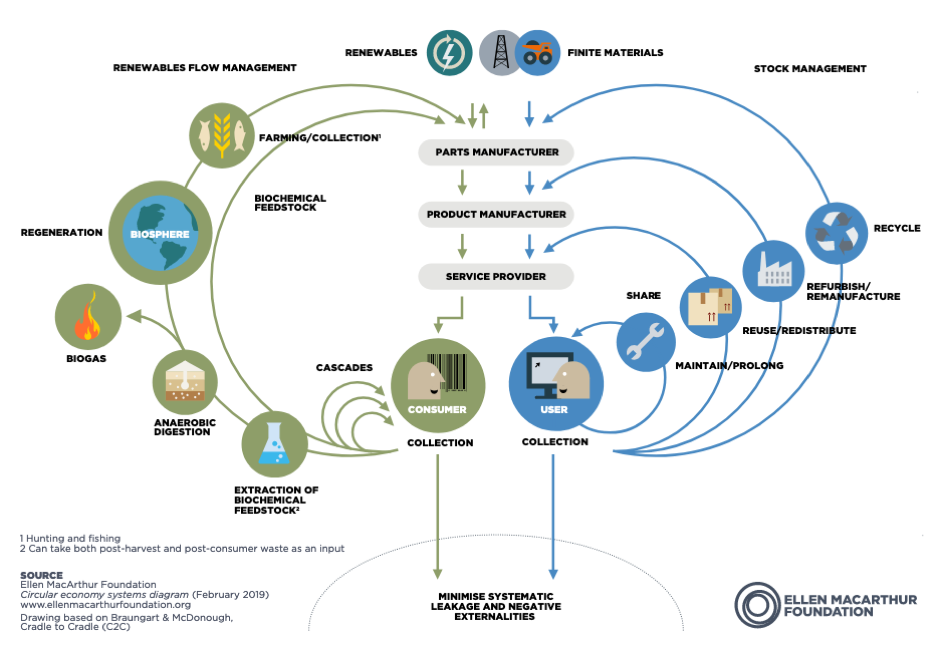Why is the path to a resilient economy circular?
By keeping materials in use, businesses can decouple economic activity from the consumption of raw materials, the extraction and transportation of which is often exposed to climate impacts.
I
n order to meet the challenge of decarbonising the global economy in the first half of this century, and also build resilience to the effects of climate change that are now inevitable, it is important that action penetrates all parts of the global economy. To do this effectively, approaches are needed that tackle the climate change at the systems level, and deal with greenhouse gas emissions reductions and climate change adaptation simultaneously, recognising their interconnections.
A new report, Completing the Picture: How the Circular Economy Tackles Climate Change, released by the Ellen MacArthur Foundation, outlines how a circular economy approach to climate change offers a valuable framework that can contribute to reduced carbon emissions from materials while at the same time building a material economy that is more resilient to climate change and its impacts.
“The challenges of decarbonising the global economy and simultaneously building resilience to climate change and its impacts are too often addressed separately. To have a reasonable chance of minimising the damage that climate change will cause, the measures we deploy must systematically integrate mitigation and adaptation measures, recognising their interconnectedness.” Said Will Bugler, Senior Consultant at Acclimatise, and an external reviewer for the resilience chapter of the report. “This paper provides a valuable overview of how the circular economy approach can incorporate and strengthen climate change mitigation and resilience, potentially providing an overarching framework to support their practical implementation.”
The report,written in collaboration with Material Economics, emphasises the importance of the circular economy in cutting emissions. The report points out that moving to renewables can only address 55% of global greenhouse gas emissions. In order to make progress on the remaining 45% the report says that a circular economy approach should be adopted across five key sectors: cement, plastics, steel, aluminium, and food.
“Adopting a circular economy framework in these areas can achieve a reduction totalling 9.3 billion tonnes of greenhouse gases in 2050.” The report states, “this is equivalent to eliminating current emissions from all forms of transport globally.”
A framework for climate resilience
The mechanisms by which a circular economy approach might reduce GHG emissions are relatively established and easily quantifiable. Designing out waste and pollution, reducing the amount of raw materials needed and increasing the amount of utility from each unit of material will lead to a drop in overall GHG emissions as fewer raw materials will need to be extracted and processed (see the image below).

However, the report also begins to explain how the circular economy approach can also lead to a material economy that is more resilient to the impacts of climate change. The paper points to several areas where this applies, for example, in keeping materials in use, businesses can decouple economic activity from the consumption of raw materials, the extraction and transportation of which is often exposed to climate impacts. Circular economy approaches often require approaches that build greater flexibility into manufacturing processes and encourage diversity in supply chains, this too can reduce risk exposure. Similarly, in the food system, regenerative agriculture improves the health of soil leading to a greater capacity to absorb and retain water, which can increase resilience against both intense rainfall and drought.
The circular economy approach lends itself to climate resilience building as it necessitates a systemic view of the material economy and the interconnections within it. Taking this approach might, therefore, allow for climate resilience assessments to be more easily performed, and areas of concentrated climate risk to be identified.
As the report itself acknowledges, more research is needed to help understand the interlinkages and overlaps between resilience frameworks and the circular economy. There is no guarantee that resilience is strengthened as a necessary bi product of the circular economy approach, but the potential for the circular economy to be a vehicle for addressing both greenhouse gas emissions and climate resilience simultaneously is one that is worthy of a lot more exploration.
The ideas presented in this article aim to inspire adaptation action – they are the views of the author and do not necessarily reflect those of the Global Center on Adaptation.